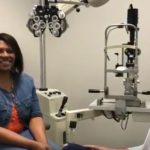
“This is the best I have ever seen in my life and I’m very excited about the things I will be able to accomplish now.”
Our patient which is featured in this video, was -10.00 before her surgery. If you are reading this and have looked at LASIK options before, you will know this number means someone is VERY nearsighted and cannot see well far away.
This patient wore glasses for the majority of her life. The glasses limited all her activity which she talks about here. As you can imagine, swimming and many other summer activities are always an issue for people imprisoned in glasses.
Sometimes, those patients who REALLY want vision correction procedures are “not candidates” and this is one of the reasons – they are TOO nearsighted. Or their corneas are not stable. Sometimes, they have passed the age and have started to venture into presbyopia after 40 years old so they also cannot see up close very well. In these cases LASIK is not an option for them. So what is?
In my 12 years of working in ophthalmology (and no I am not a doctor) I have always heard about RLE or Refractive Lens Exchange. It is not something most patients or consumers know about because we either think LASIK or Cataract surgery when we think “eye surgery.” Well in many cases, Refractive Lens Exchange is the number one option for patients with these circumstances.
“This is the greatest day of my life.” “ I can sleep without glasses, I am so excited.”
We could not say it better ourselves. For a patient to have this kind of reaction, you know they endured years of limited activity and shying away from surgeries that would likely not be fruitful or safe for their vision.
To break it down in non-medical terms, Refractive Lens Exchange is pretty much the exact same procedure as Cataract Surgery, except the lenses the surgeon removes from a patient’s eyes are not yet plagued by cataracts. Cataracts, which form with age and exposure to UV light, have to be removed later in life and replaced with intraocular lenses (a nice word for artificial lenses). In a Refractive Lens Exchange, there is no full cataract formed yet – the skilled surgeon is basically swapping out your natural lenses, which are obviously faulty with your visual issues, for some new artificial/intraocular lenses. Same procedure.
So if there’s no cataract, why would you want the procedure?
A cataract means that the natural lens is cloudy and vision is impaired. But cloudiness isn’t the only thing that happens to the natural lens over time. It’s simply the last straw. For people having Refractive Lens Exchange, they do it for two reasons.
The first is that the natural lens by age 40-45 has become stiff and lot its ability to change shape to focus from distance to near. Not quite cloudy yet, but stiff. The stiffness, which we call presbyopia, typically requires either reading glasses or bifocals. And when Dr. Slade or Dr. Walton perform RLE surgery, they often use a lens technology that gives a broader range of vision than a typical single-focus lens.
The second reason is to correct nearsightedness, farsightedness or astigmatism. Some people’s eye anatomy may be a better fit for LASIK than RLE, and others better for RLE than LASIK. As always, make sure to get an opinion from surgeons who perform all the options, rather than a one-size-fits-all.
Another difference is cataract removals are generally covered by insurance. Refractive Lens Exchanges are not. This would make them an “elective vision correction procedure” like LASIK which is also a non-covered procedure.
However, when you are ready to get good vision without the use of glasses or contacts, no one stops the thousands of patients a year who get LASIK, so why not ask about this option if you have any of the issues mentioned?
If you have any of the below issues, you may be a Refractive Lens Exchange Candidate:
- You are “too nearsighted” or too myopic for LASIK (usually above a -8.00 RX) (like the video)
- Already having trouble seeing up close (presbyopia)
- Having to buy reading glasses to see the menu at a restaurant
- Blowing up the font on your iPhone to read text messages
- Holding things far away from your face to read them better (magazines, phones, tablets, menus)
We recently posted a great NY Times article which you can see here and it covered the life changing parts of cataract surgery. Today, we wanted to share that you don’t have to wait until cataracts have gradually deteriorated your vision to make a change.
Call us today at 713-626-5544 if you are interested or even if you just have questions! That is what we are here for!





